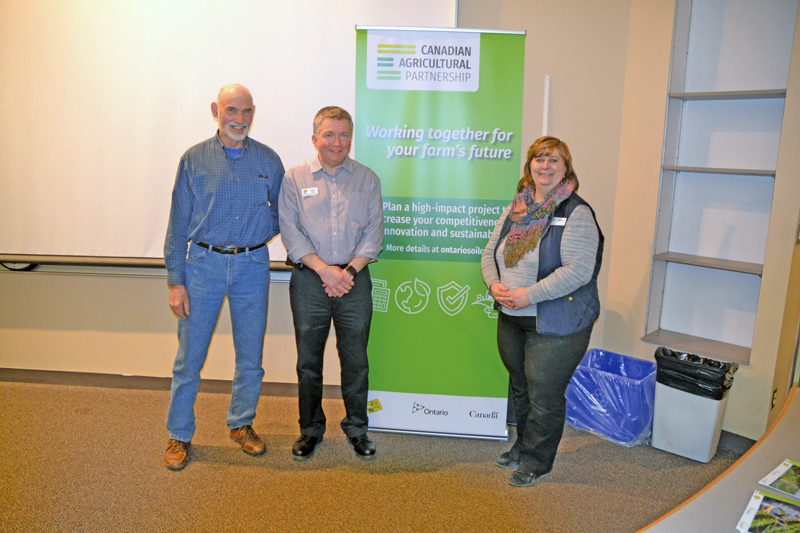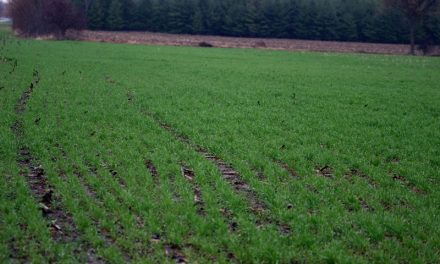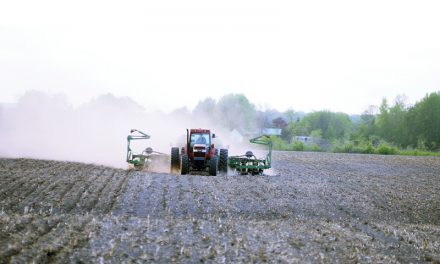Farm futures
OSCIA president Peter McLaren, OSCIA program manager John Laidlaw and OSCIA program lead Colleen Acres spoke to producers and agribusiness owners on April 11 about the Canadian Agricultural Partnership, replacing Growing Forward 2. Sawyer Helmer photo
by Kalynn Sawyer Helmer
AgriNews Staff Writer
KEMPTVILLE – The Ontario Soil and Crop Improvement Association (OSCIA) rolled out the newest five-year program, Canadian Agricultural Partnership (CAP), to replace Growing Forward 2 (GF2).
CAP has many similar features to its predecessor under the cost-sharing framework. Yet one big change is that there are now more dynamic cost-sharing options. While GF2 featured either 50 per cent or 35 per cent cost-sharing, CAP has introduced more options to put emphasis on different programs.
“The Ontario Soil and Crop Improvement Association (OSCIA) is pleased to be delivering the new Canadian Agricultural Partnership programming to producers and other agribusiness across Ontario. For over 30 years OSCIA has played a large role in delivering various programs to producers and looks forward to working with the federal and provincial governments in delivering this five-year initiative,” said Peter McLaren, president OSCIA.
As with GF2, programs are separated by streams. CAP has introduced a new stream for other business to provide support to agriculture-related businesses. Some examples include commercializers, plant health or animal health businesses.
OSCIA provided an information session to interested people on Wed., April 11 at Kemptville College. The session aimed to provide an overview of the new program. CAP aims to simplify the process and has created three separate program guides for economic development, environmental stewardship and protection and assurance.
For all programs producers must have a valid Farm Business Registration Number (FBRN) and new producers with a FBRN can apply to non-capital-type projects. “They are eligible for audits, assessment plans and any educational component that still fits within the program. But something like equipment would not be eligible,” said program manager John Laidlaw.
To get an FBRN, producers must have $7,000 in gross farm income. If that gross income is not achieved in the two and three previous years before application but is projected to in the next three years, then producers can qualify as a new producer, Laidlaw explained.
The main subsections under economic development are business analysis, market development and productivity. CAP has placed a greater focus for this program on marketing. While business plans still have the same opportunities as they did under GF2, there are more opportunities for marketing plans. “That is where the outcomes are that the CAP is looking for. With each program, Growing Forward, Growing Forward 2 and now the Canadian Agricultural Partnership, the focus sort of shifts with each one and the sort of things they are looking at. Right now there is a bigger focus on domestic and international marketing. The opportunities for planning with the exception of succession plans, is the same as it was before,” said Laidlaw.
With those outcomes in mind, succession planning is no longer a valid program under CAP. “The outcomes we are looking for under the CAP program, succession plans didn’t achieve those outcomes. The Canadian Agricultural Partnership is very outcome-driven. They have certain goals and objectives that they are looking for and they felt that the succession plans didn’t meet those outcomes,” Laidlaw explained.
As for productivity, labour productivity plans and technology and equipment to improve labour productivity have been separated into two categories. To qualify for the latter, the technology is required to be relatively new and only used by about 20 per cent of the industry. Laidlaw explained the technology must be considered cutting edge or in the early adaptive stage. “We are looking for new or unique aspects of labour productivity technology. We have seen some where there is new technology or machinery that also has the labour productivity components.”
After Laidlaw finished with the economic development section, Colleen Acres, OSCIA program lead, outlined the environmental stewardship guides. To be eligible for programs under this section, producers must have a valid Environmental Farm Plan (EFP). While the current EFP courses are working in the fourth edition, third edition EFPs are valid as well.
A big part of the environmental stewardship guide reflects ministry-level commitments identified in the Canada-Ontario Lake Erie Action Plan or Ontario’s Draft Agricultural Soil Health and Conservation Strategy. It also places an emphasis on collaborating with pollinator habitat and climate change.
Under the new CAP eastern Ontario producers are now able to apply to all programs in the environmental stewardship section. The previous geological restrictions have been dismantled. It also features a 5 per cent systems approach bonus. Acres explained during the presentation that “the purpose is continuous improvement through the on-going implementation of multiple soil health and water quality best management practices.” The presentation slides outline that producers could be eligible for the 5 per cent bonus if they can meet Systems Approach Eligibility requirements.
There are new options for adding organic amendments, the implementation of cover crops and runoff control practices. CAP also no longer requires confirmation from a livestock specialist to apply for manure storage.
Acres moved on to the protection and assurance which covers animal health, food safety and plant health. Under CAP there are more projects in this category. Also new in the section is traceability integrated with food safety and animal health and more flexibility to respond and target various risks.
In the previous program welfare and health programs were separate but have now been amalgamated into one section. There is also a distinction between traceability equipment and traceability system improvements.
The programs under this section do not require an EFP but do require biosecurity workshops. These workshops must be taken in person with no online options available. The workshops can vary from plant and crop to animal health options depending on the desired applications.
“Global demand is growing for the products and food our farmers and processors can deliver. The investments that will be made by the governments of Canada and Ontario through the Canadian Agricultural Partnership will give the sector the tools needed to meet that demand and help it innovate, grow, and prosper. By supporting our farmers and food processors, we will be creating well-paying middle-class jobs while working towards our objective of expanding agricultural exports to $75-billion by 2025,” said Lawrence MacAulay, Minister of Agriculture and Agri-Food Canada.
For producers wishing to find out more, detailed program guides are available online at ontarioprogramguides.net and applications can be made through the online portal at ontarioprograms.net. Producers who have applied under Growing Forward or GF2 can log in and have all their previous information available. CAP is no longer accepting faxed applications but will still accept mail courier, email or online.













